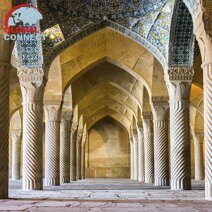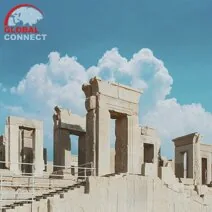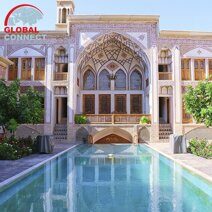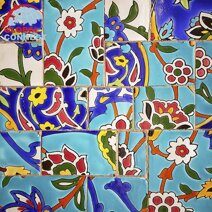Phones:
Mobile: +998941800001 (whatsapp, telegram)
Email:
karimov.sai@gmail.com
info@globalconnect.uz
Address:
str.Nodirabegim 6/22, 140103, Samarkand, Uzbekistan
We are next to Kapitalbank. Parking space is available in front of the building.
Office Hours:
9:00 am - 8:00 pm from Monday to Saturday
Iran General Information
General Information about Iran
General Information
Iran, officially known as the Islamic Republic of Iran, is a country located in Western Asia with an area of approximately 1,648,195 square kilometers (636,372 square miles), making it the 18th largest country in the world. Iran has a population of over 83 million people, making it the 17th most populous country globally.
Iran is bordered by Iraq to the west, Turkey to the northwest, Armenia and Azerbaijan to the north, Turkmenistan to the northeast, Afghanistan and Pakistan to the east, and the Persian Gulf and the Gulf of Oman to the south.
Iran is an Islamic republic with a Supreme Leader as the highest authority. The President is the head of government. The capital city of Iran is Tehran.
 |
 |
 |
Independence
Iran gained its independence from foreign control and achieved its modern form as a nation-state in the early 20th century.The specific timeline of Iran's independence can be divided into two significant events:
Constitutional Revolution (1905-1911) and End of Foreign Influence (1935).
It's worth noting that Iran's path to full independence and sovereignty has been shaped by various historical events and developments throughout the 20th century, including the overthrow of the Pahlavi monarchy and the establishment of the Islamic Republic of Iran in 1979.
National Flag
 The national flag of Iran, also known as the Three-Colored Flag or the Tricolor, consists of three horizontal bands of green, white, and red, with the national emblem of Iran centered in the middle of the white band. The current tricolor flag was officially adopted on July 29, 1980, after the Iranian Revolution of 1979. The national flag of Iran is an important symbol of the country's identity and is displayed on various occasions, including national holidays, government buildings, and during international events.
The national flag of Iran, also known as the Three-Colored Flag or the Tricolor, consists of three horizontal bands of green, white, and red, with the national emblem of Iran centered in the middle of the white band. The current tricolor flag was officially adopted on July 29, 1980, after the Iranian Revolution of 1979. The national flag of Iran is an important symbol of the country's identity and is displayed on various occasions, including national holidays, government buildings, and during international events.
Design:
- The flag is rectangular in shape, with a ratio of 4:7 (width to length).
- The top band is green, symbolizing growth, happiness, unity, and nature.
- The middle band is white, representing peace, freedom, and honesty.
- The bottom band is red, symbolizing bravery, courage, and martyrdom.
- The national emblem, a stylized version of the word "Allah" (God) in Arabic script, is depicted in red in the center of the white band.
National Emblem

The national emblem of Iran, also known as the Four-Fold Emblem or the Coat of Arms, is a stylized version of the word "Allah" (God) in Arabic script. The national emblem of Iran is an important symbol of the country's Islamic heritage and is closely associated with its cultural and religious identity. It serves as a representation of the nation's faith and values.The emblem features the Arabic word "الله" (pronounced "Allah") written in a stylized calligraphic script known as Kufic.
It became an official national emblem following the Iranian Revolution of 1979, which led to the establishment of the Islamic Republic of Iran. The emblem is prominently featured on the national flag and is also used on official documents, government buildings, and various national symbols.
Design:
- The emblem features the Arabic word "الله" (pronounced "Allah") written in a stylized calligraphic script known as Kufic.
- The script is formed by repeating the letters "الله" in a geometric pattern, creating a square shape.
- The word "Allah" is written in red, against a white background.
National Anthem
The national anthem of Iran is called "Soroud-e Melli-e Jomhouri-e Eslami-e Iran" in Persian, which translates to "National Anthem of the Islamic Republic of Iran" in English. The national anthem was officially adopted on April 1, 1990, by the Islamic Consultative Assembly (Iran's Parliament).
Provinces
Iran is divided into 31 provinces, also known as ostāns. Each province has its own governor appointed by the central government. The provinces are further divided into counties (shahrestan), districts (bakhsh), and sub-districts (dehestan). Here is a list of the 31 provinces in Iran:
- Alborz
- Ardabil
- Bushehr
- Chaharmahal and Bakhtiari
- East Azerbaijan
- South Azerbaijan
- Fars
- Gilan
- Golestan
- Hamadan
- Hormozgan
- Ilam
- Isfahan
- Kerman
- Kermanshah
- North Khorasan
- Razavi Khorasan
- South Khorasan
- Khuzestan
- Kohgiluyeh and Boyer-Ahmad
- Kurdistan
- Lorestan
- Markazi (Central)
- Mazandaran
- Qazvin
- Qom
- Semnan
- Sistan and Baluchestan
- Tehran
- Yazd
- Zanjan
Each province has its own unique cultural, geographical, and historical characteristics, contributing to the diversity of Iran's regions.
 |
 |
 |
National Currency
The national currency of Iran is the Iranian Rial (IRR). The rial is abbreviated as "﷼" and is represented by the symbol "ریال" in Persian. The rial is available in banknotes and coins of various denominations. Banknotes are issued in denominations of 100,000, 50,000, 20,000, 10,000, 5,000, 2,000, and 1,000 rials. Coins are available in denominations of 500, 250, 100, 50, 20, and 10 rials, although coins are not frequently used in everyday transactions.
The rial is divided into smaller units called "dinars," but dinars are not commonly used in everyday transactions. The subunit most commonly used is the "toman," which is equal to 10 rials. Prices are often quoted in tomans rather than rials, although the official currency is the rial.
Foreign Currency Exchange
Unfortunately, you cannot use your Master's or Visa cards in Iran. That’s why you need to exchange your money and have cash on you all the time. You can exchange US dollars, Euros, and British pounds for the Iranian Rial in official exchange offices.
Climate
Iran experiences a diverse range of climates due to its vast size and varying geographical features. The majority of Iran has a continental climate with distinct seasons. Summers tend to be hot and dry, while winters can be cold with some regions experiencing snowfall. The central plateau, including Tehran, has a continental climate. The average summer temperature in most of the country are between 30 and 36 °C (89-97 °F). In northern and western regions of Iran the average winter temperature are between 1 to 8 °C (34-46 °F). Southern coasts are usually warmer.
Iran Cuisine
Iranian cuisine, also known as Persian cuisine, is renowned for its rich flavors, aromatic spices, and a wide variety of dishes. Iranian cuisine has a long history and reflects the country's diverse cultural influences. Rice is a staple food in Iran and is a central component of many meals. The most famous Persian rice dish is "Chelo" or "Polow," which is cooked with saffron, creating a vibrant yellow color and distinct aroma. Other rice-based dishes include "Tahchin" (baked rice with meat or vegetables), "Sabzi Polo" (rice with herbs), and "Baghali Polo" (rice with fava beans and dill).
Iranian cuisine emphasizes the use of fresh ingredients, aromatic herbs, and a balance of flavors. It is often enjoyed in a communal setting, with family and friends gathering around a shared meal. The country's diverse regional cuisines contribute to the richness and variety of Persian culinary traditions.
Religion
The predominant religion in Iran is Islam, specifically the Shia branch of Islam. The Shia Islam is the official state religion of Iran, and a majority of Iranians adhere to it. Iran's government and legal system are based on Islamic principles, and Islamic religious authorities have significant influence over various aspects of society. However, individuals' level of religious observance can vary, and there is a diversity of religious interpretations and practices within the country.
Iran is home to several religious minority communities, including Christians, Jews, Zoroastrians, and Baha'is. These communities have existed in Iran for centuries and have their own distinct religious beliefs and practices. However, they form a small percentage of the overall population.
Holidays
- Nowruz in Iran
- Anniversary of the Iranian Revolution
- Oil Nationalization Day
- Islamic Republic Day
- Sizdah Bedar
- Death of Imam Khomeini
- Khordad National Uprising
- Birthday of Imam Ali
- Mabaath
- Martyrdom of Hazrat Fatemah
- Prophet Muhammad's Birthday
- Birthday of Imam Sadeq
- Martyrdom of Imam Hassan Asgari
- Martyrdom of Imam Reza
- Martyrdom of Imam Hasan
- Death of Prophet Muhammad
- Arbaeen
- Ashura
- Tassoua
- Eid al-Ghadir
- Eid al-Adha in Iran
- Martyrdom of Imam Sadeq
- Eid al-Fitr in Iran
- Martyrdom of Imam Ali
- Birthday of Imam Mahdi
International dialing code: +98
Iran GDP (Gross Domestic Product) is 388.54 Billion US dollars (2022). Published by the World Bank.
